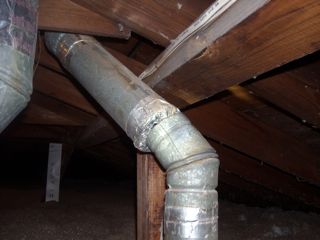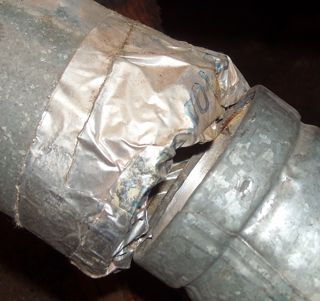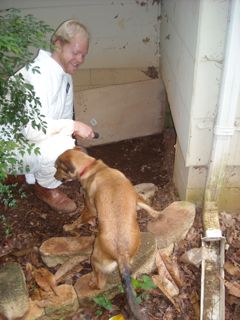Combustion Safety Rule #1: Remove Exhaust Gases from House

 So, I was out on a field test with a new HERS rater the other day, and we took a look up in the attic. The scuttle hole is right next to the closet where the natural gas water heater lives, and the flue comes up into the attic right there where we poked our heads up. The photo at left shows the flue pipe going up and then making a turn before exiting the roof.
So, I was out on a field test with a new HERS rater the other day, and we took a look up in the attic. The scuttle hole is right next to the closet where the natural gas water heater lives, and the flue comes up into the attic right there where we poked our heads up. The photo at left shows the flue pipe going up and then making a turn before exiting the roof.
So, I was out on a field test with a new HERS rater the other day, and we took a look up in the attic. The scuttle hole is right next to the closet where the natural gas water heater lives, and the flue comes up into the attic right there where we poked our heads up. The photo at left shows the flue pipe going up and then making a turn before exiting the roof.
See that little offset there right above the turn? If it looks like it’s not making a good connection, that’s because it’s not making a good connection. In fact, when the new EVER rater went up there first, it looked worse than what you see here because he’d already put the two sections near each other when I got a chance to take the photo. You can see a little better in the photo below right that even though those two sections are near each other, they’re not connected.
near each other, they’re not connected.
Yeah, this is happening in a vented attic, not inside the building envelope, so why worry about it, right? Wrong. You want those exhaust gases to get all the way outside the house. You don’t want them in a buffer space like the attic because it’s still likely they could find their way into the house. Exhaust fans and clothes dryers can cause the house pressure to go negative relative to the attic and suck those flue gases into the house, for example.
It’s amazing how blatantly obvious so many building science and combustion safety problems are once you know a little bit about how things work. Actually, you don’t even have to have any training to know that when a pipe is supposed to be carrying something from point A to point B, it has to be continuous for the something to reach point B. I wrote an article about duct leakage last year that shows some obvious problems that take only a pair of eyes to find.
The field test went well, though, and Luke Bertram of Green Summit Consulting is our newest EVER rater. He took our HERS rater class in February and was one of the lucky ones to have his training and certification costs covered by ARRA (Stimulus) money. The City of Doraville, Georgia is really on the ball and is getting people trained to provide subsidized energy audits to city residents. Here’s Luke in his Tyvek suit, about to enter the cave of mystery (aka crawl space) under the test house.

This Post Has 4 Comments
Comments are closed.

Great article Allison &
Great article Allison & congrats to Luke for becoming a HERS Rater.
Great article Allison!&
Great article Allison!
One common disconnect in the venting system that seems to get taken for granted is the draft hood on top of any natural draft appliance.
This is the exact same principle that you are referring to in this article in regards to disconnects in the venting system.
When most energy professionals find a hole in a venting system like the one you’ve posted in this picture it gets repaired ASAP.
A draft hood which is the exact same type of hole is never taught to be repaired, instead it is taught to be smoke tested for one minute under worst case depressurization conditions.
Makes you wonder why we classify and address holes in a venting system differently depending on their location.
Sean:
Sean: Thanks. Luke’s going to be a great rater and he’s working for a great company.
David: Good point about the draft hood. Most people think it’s OK because the flue gases go straight up into it. That’s true except when it’s not, which is more often than most people think. And then there’s the problem of common venting with furnaces, which overrides the safety feature that cuts off furnaces when they’re not drafting properly. I discussed this in an article on atmospheric combustion a couple of months ago.
Maybe slightly off of this
Maybe slightly off of this specific topic, but related to combustion safety, nonetheless……
I am a BPI certified Building Analyst / Envelope Professional (can’t say energy auditor any more because that’s now a separate certification), and I do energy audits.
I use a Bacharach Fyrite Model 60 Combustion Analyzer to evaluate CO, O2, Combustion Efficiency, etc.
Well, my trusty Combustion Analyzer now wants to have its O2 sensor changed.
Has anyone done that themselves, and if so, where in the NYC / NJ metropolitan area (Philadelphia area too) can you get an O2 sensor, and probably also a CO sensor for this analyzer?
Also, once I change these sensors, do I then have to calibrate the instrument, or are “new” sensors already calibrated?
Any advice / help on this would be much appreciated!!
Ira Eisenstein
732-497-2674
iraeise@me.com